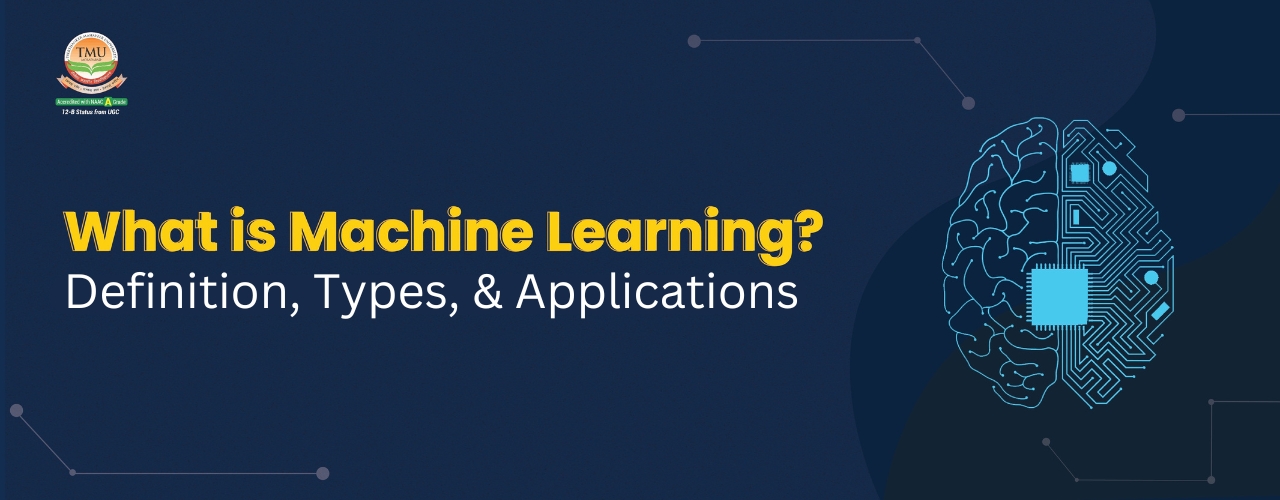What is Machine Learning? Definition, Types, & Applications
Machine learning is transforming our world, making it possible for systems to learn from data, improve with experience, and perform tasks without explicit programming. But what is it really, and why is it becoming so central in technology?
What is Machine Learning?
Machine learning (ML) is a subset of artificial intelligence (AI) that enables computers to automatically learn from data patterns, make predictions, or execute tasks with minimal human intervention. ML has evolved into a dynamic field with the potential to reshape industries and change the way we approach problem-solving.
Why is Machine Learning Important?
Machine learning is essential because it can process vast amounts of data quickly and generate insights or predictions that would take humans much longer. This allows for innovation in industries ranging from healthcare to finance, as organisations can improve decision-making, enhance customer experiences, and even develop new products.
Defining Machine Learning
Machine Learning vs. Traditional Programming
Unlike traditional programming, which involves writing explicit rules for a machine to follow, machine learning enables the system to create its own rules based on the data it analyzes. This adaptability and flexibility make ML especially powerful for handling complex problems that are challenging to solve manually.
Key Components of Machine Learning
Machine learning models rely on a combination of algorithms, data, and computing power. Critical elements include:
- Algorithms: Provide the set of instructions for data processing.
- Data: Enables the model to learn patterns and make predictions.
- Training: The phase where models are developed and refined for accuracy
How Machine Learning Works
The Data-Driven Approach
Machine learning relies heavily on data, making the initial phases of data collection, preprocessing, and analysis crucial.
Data Collection and Preprocessing
Data collection involves gathering a dataset that accurately represents the problem the ML model is trying to solve. Once collected, the data must be cleaned and formatted, as raw data can contain inconsistencies or irrelevant information.
Feature Selection and Engineering
Feature engineering is selecting the essential data features that directly impact the accuracy of the model. This step helps reduce data noise and enhances model performance.
Training and Testing Models
Once the data is prepared, the model is trained on a portion of it to recognize patterns. The remaining data is reserved for testing, allowing developers to evaluate how well the model performs on new, unseen data.
Types of Machine Learning
| Type of Machine Learning | Description | Examples | Applications |
| Supervised Learning | The model is trained on labelled data, where each example has a known output. | Predicting house prices, spam detection, image classification | Medical diagnostics, fraud detection, email filtering |
| Unsupervised Learning | The model learns from unlabelled data, finding patterns or structures on its own. | Clustering customer data, anomaly detection, market segmentation | Customer segmentation, recommendation systems, market analysis |
| Semi-Supervised Learning | The model is trained on a small amount of labelled data and a larger amount of unlabelled data. | Partially labeled datasets for voice or image recognition | Text processing, image classification, voice recognition |
| Reinforcement Learning | The model learns by receiving rewards or penalties based on its actions, optimizing decision-making over time. | Robotics, autonomous driving, game AI | Robotics, autonomous vehicles, advanced gaming strategies |
Key Algorithms in Machine Learning
Linear Regression
Linear regression is used for predicting numerical values, such as forecasting sales.
Decision Trees
Decision trees help models make decisions based on a series of criteria, useful for classification tasks.
Neural Networks
Neural networks, inspired by the human brain, excel at recognising complex patterns and are foundational in deep learning.
Applications of Machine Learning
| Application Area | Description | Examples |
| Healthcare | Enhances diagnostics, personalized medicine, and predictive analytics | Medical image analysis, drug discovery, patient risk prediction |
| Finance | Optimizes financial processes and increases fraud detection accuracy | Credit scoring, algorithmic trading, fraud detection |
| Retail | Improves customer experience, inventory management, and demand forecasting | Personalized recommendations, dynamic pricing, stock management |
| Transportation | Enhances logistics, route optimization, and autonomous vehicle capabilities | Self-driving cars, demand forecasting, fleet management |
| Manufacturing | Improves quality control, predictive maintenance, and automation of production processes | Defect detection, equipment maintenance, production automation |
| Education | Personalizes learning experiences, assists with administrative tasks, and tracks student progress | Adaptive learning platforms, grading automation, student analytics |
| Agriculture | Optimizes crop management, predicts yields, and monitors soil and plant health | Crop monitoring, pest detection, yield prediction |
| Entertainment | Provides personalized content recommendations and improves user experience | Movie/music recommendations, content creation, game personalization |
| Energy | Enhances energy consumption forecasting and optimizes grid management | Smart grid management, consumption prediction, energy efficiency |
| Security and Surveillance | Assists with facial recognition, anomaly detection, and automated monitoring | Intrusion detection, CCTV monitoring, access control |
Benefits of Machine Learning
Enhanced Efficiency and Automation
ML systems improve efficiency, taking over repetitive tasks and allowing humans to focus on more strategic activities.
Improved Accuracy and Decision-Making
With precise data analysis, ML models make accurate predictions, assisting in decision-making across various fields.
Challenges and Limitations of Machine Learning
Data Privacy and Security Concerns
As data drives machine learning, issues of privacy and security are prominent, especially in sensitive industries like healthcare.
Need for Large Datasets
ML models need substantial data to achieve accuracy, which can be a challenge in data-scarce fields.
Model Interpretability
Understanding complex models can be challenging, especially when decisions need to be justified.
Future of Machine Learning
Potential Developments
As ML evolves, we can expect advancements in deep learning, quantum computing integration, and more intelligent, adaptive systems.
Ethical Considerations
Ethics in ML, such as bias reduction and transparency, will be critical as technology becomes more embedded in daily life.
Machine Learning Course
Machine learning courses cover the fundamentals of algorithms, data processing, and model building. Typical topics include supervised and unsupervised learning, neural networks, deep learning, data preprocessing, and programming languages like Python or R. Many courses also offer hands-on projects, allowing learners to apply skills to real-world problems.
| Course Level | Description | Typical Duration | Key Skills Developed |
| Diploma in Machine Learning | Introductory program covering fundamental concepts and basic ML algorithms, ideal for beginners | 6 months - 1 year | Basics of ML, data preprocessing, simple algorithms |
| Bachelor’s in Technology (B.Tech) in Machine Learning or AI | Undergraduate program focused on ML algorithms, data structures, and mathematics for AI applications. | 4 years | Algorithm design, data structures, programming, statistics, ML foundations |
| Master’s in Technology (M.Tech) in Machine Learning or AI | Advanced study with specialized courses in ML, deep learning, computer vision, and NLP. | 2 years | Advanced ML, deep learning, research methods, specialized applications |
| Ph.D. in Machine Learning or Artificial Intelligence | Research-oriented program aimed at developing new theories, methods, or technologies in ML. | 3 - 6 years | Research methodologies, advanced ML concepts, publishing papers, innovative ML solutions |
Careers in Machine Learning
Machine learning offers diverse career paths in technology, finance, healthcare, and more. Key roles include:
- Machine Learning Engineer: Builds and optimizes ML models.
- Data Scientist: Analyzes data and develops insights using ML algorithms.
- AI Specialist: Focuses on integrating AI and ML solutions into business processes.
- Research Scientist: Conducts research on new ML methods and technologies. Other roles include data analyst, NLP specialist, and robotics engineer.
Conclusion
Machine learning is rapidly reshaping industries and improving our understanding of data. From predictive analytics to personalized customer experiences, ML is a driving force for modern innovation. As machine learning continues to evolve, it will bring both challenges and exciting possibilities, promising a future where data-driven decisions become more precise and insightful.
FAQs
Q1) What is in machine learning?
A) Machine learning is a branch of artificial intelligence (AI) that enables systems to learn from data, identify patterns, and make decisions with minimal human intervention. It involves training algorithms on large datasets so they can improve their accuracy and performance over time. Machine learning powers applications like predictive analytics, image and speech recognition, recommendation systems, and autonomous vehicles, and is widely used across sectors like healthcare, finance, retail, and more.
Q2) What are the 4 types of machine learning?
A) The four main types of machine learning are:
- Supervised Learning: The model is trained on labeled data, where each example includes an input-output pair. It learns to map inputs to the correct output. Examples include email filtering and fraud detection.
- Unsupervised Learning: The model is trained on unlabeled data and must find patterns or groupings on its own. It’s commonly used for clustering, like grouping customers with similar behaviors.
- Semi-Supervised Learning: This approach uses a small amount of labeled data and a larger amount of unlabeled data. It’s helpful in situations where labeling data is costly, such as image or text classification.
- Reinforcement Learning: The model learns by receiving rewards or penalties based on its actions. It’s used for decision-making tasks over time, such as training robots or developing game AI.
Q3) Which is better, AI/ML or data science?
A) Choosing between AI/ML and data science depends on the goal and application.
AI/ML (Artificial Intelligence and Machine Learning) focuses on building models that can learn from data to make predictions, automate tasks, and improve systems over time. It’s ideal for applications requiring decision-making, automation, and complex pattern recognition, like image analysis or autonomous driving.
Data Science centers on extracting insights and actionable knowledge from data, using statistical methods, visualization, and data analysis. It’s better suited for understanding trends, performing analytics, and supporting strategic business decisions.
In summary, AI/ML is optimal for automation and predictive tasks, while data science excels in data-driven insights. Both fields often complement each other in data-driven projects.
Q4) Why is machine learning important?
A) Machine learning is important because it enables computers to process and learn from vast amounts of data, making predictions and automating tasks without human intervention. This leads to smarter decision-making, increased efficiency, and innovative solutions across various industries, from healthcare and finance to retail and transportation. By uncovering patterns and insights, machine learning drives advancements, improves customer experiences, and helps businesses operate more effectively in a data-driven world.




Comments (0)